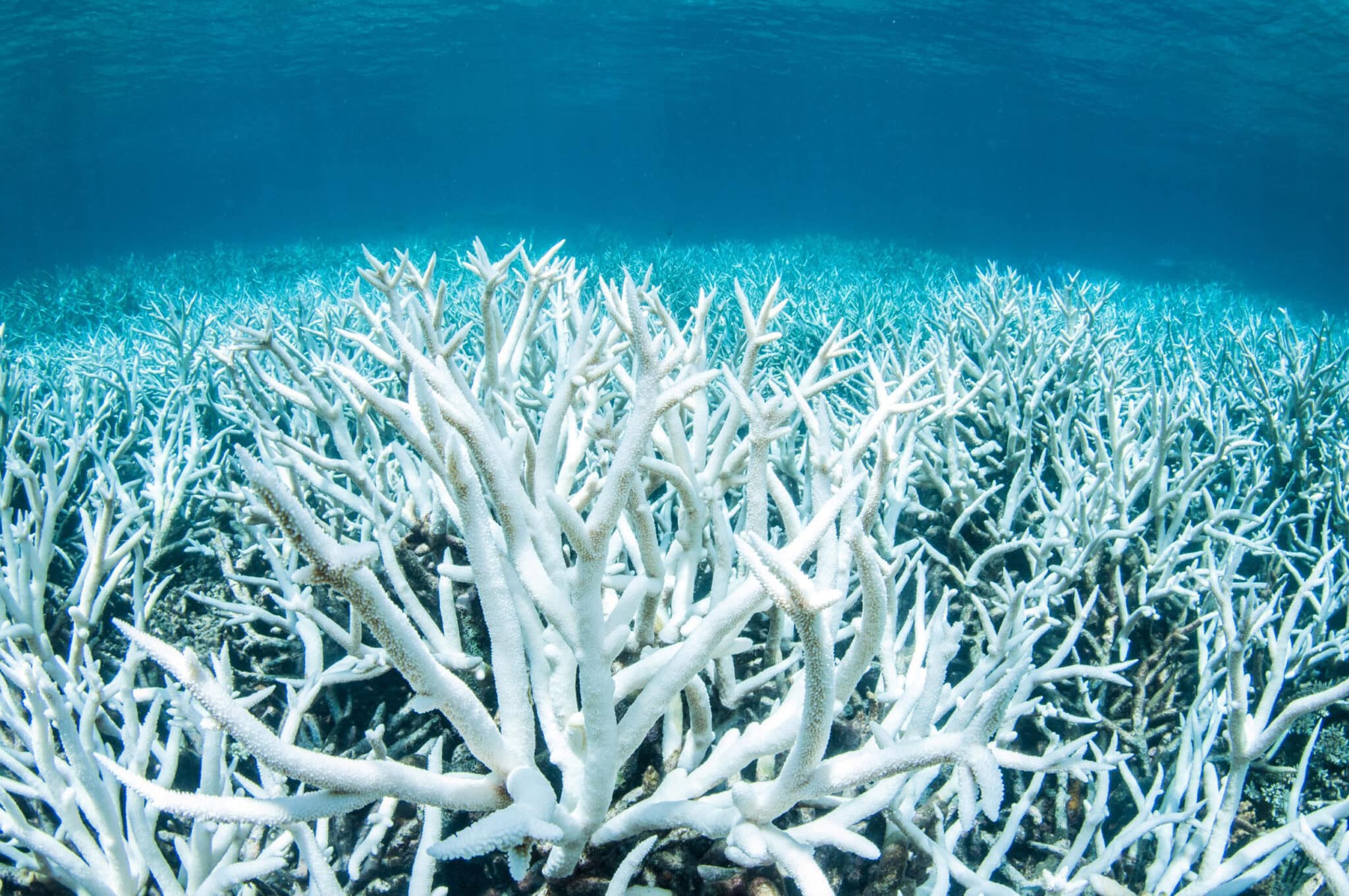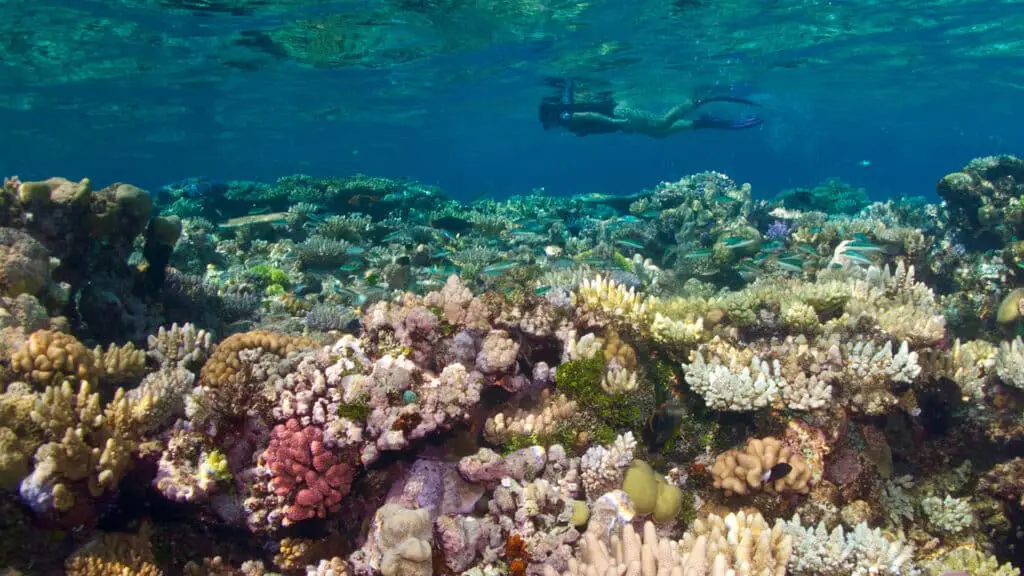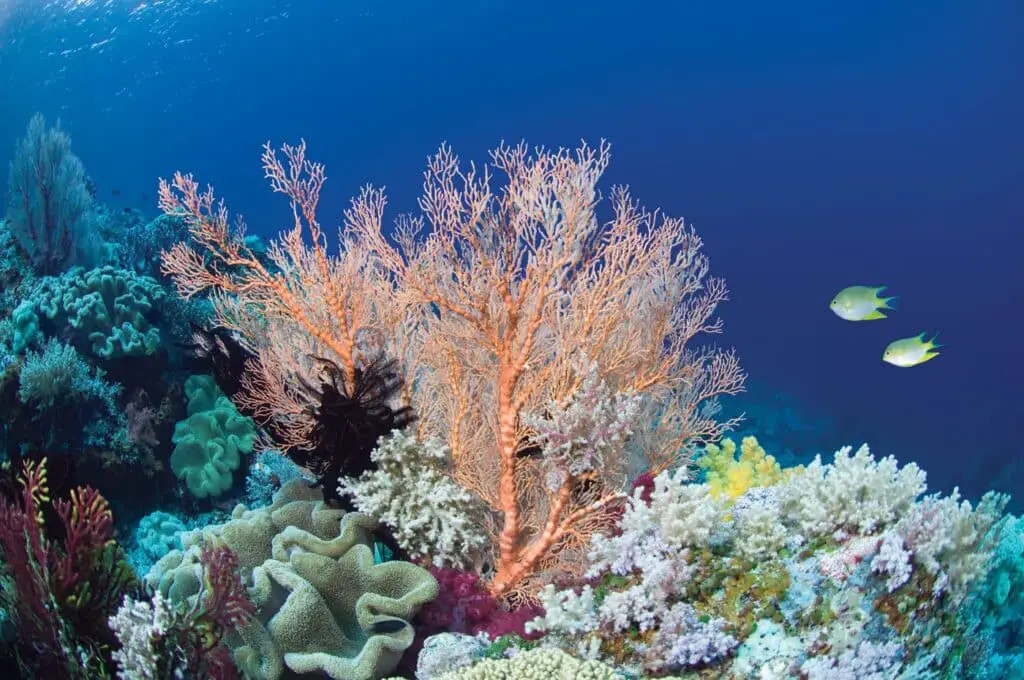What Is The Weather In The Coral Reef

Introduction
What Is The Weather In The Coral Reef: The weather in the Coral Reef, one of the Earth’s most mesmerizing and ecologically diverse environments, plays a pivotal role in shaping this unique underwater world. Nestled beneath the sunlit surface of the tropical oceans, coral reefs are delicate and intricate ecosystems that rely on specific weather conditions to thrive.
At the heart of the Coral Reef’s weather story is its connection to the sun. These reefs predominantly exist in regions where sunlight penetrates the water, providing the energy required for the photosynthesis of symbiotic algae, which in turn feeds the coral polyps. Consequently, clear skies and abundant sunlight are essential for the health of the reef.
It also faces the challenges posed by weather extremes. Tropical storms and hurricanes, for instance, can wreak havoc on these ecosystems. Strong winds, torrential rains, and turbulent waters can damage the fragile corals and disrupt the intricate balance of life within the reef.
We will delve deeper into the intricate relationship between atmospheric conditions and the mesmerizing biodiversity of this underwater realm. We will uncover how various weather elements, from sunlight to storms, influence the delicate dance of life beneath the waves and examine the ongoing effects of climate change on this fragile ecosystem.

What is the climate of the coral reef?
Because of strict environmental restrictions, coral reefs generally are confined to tropical and semi-tropical waters. Reef-building corals cannot tolerate water temperatures below 64° Fahrenheit (18° Celsius).
The climate of the coral reef is characterized by its location within tropical and subtropical regions of the world’s oceans. These regions are known for their warm temperatures, abundant sunlight, and relatively stable weather patterns. Here are some key features of the climate that define the coral reef ecosystem:
- Warm Water Temperatures: Coral reefs thrive in water temperatures typically ranging from 75 to 85 degrees Fahrenheit (24 to 29 degrees Celsius). This warmth is essential for the growth of both coral polyps and the symbiotic algae (zooxanthellae) that provide them with nutrients.
- Abundant Sunlight: Coral reefs require clear, sunlit waters for photosynthesis to occur within the zooxanthellae, which provide corals with much of their energy. The ample sunlight in tropical and subtropical regions supports this crucial process.
- Low Seasonal Temperature Variability: Unlike temperate regions with distinct seasons, coral reef climates generally exhibit minimal seasonal temperature fluctuations. This stability allows coral ecosystems to develop and thrive year-round.
- Rainfall and Storms: While coral reefs typically experience warm and sunny conditions, they are also susceptible to tropical storms and heavy rainfall during certain times of the year. These events can have both positive and negative impacts on reef health, depending on their severity and frequency.
- Ocean Currents: The movement of ocean currents can influence the climate of coral reefs. Upwelling currents can bring nutrient-rich waters to the surface, benefiting reef ecosystems, while changes in currents can affect water temperatures and clarity.
The climate of the coral reef is characterized by warmth, sunlight, and relative stability, all of which are essential for the health and survival of the vibrant and diverse marine life that calls these ecosystems home.
Are coral reefs warm or cold?
Not all corals live in warm water – in fact, over half of all known coral species are found in cold, deep, and dark waters.
Coral reefs thrive in warm, tropical waters, typically found in temperatures ranging from 68 to 82 degrees Fahrenheit (20 to 28 degrees Celsius). They are most commonly associated with the clear, sun-drenched seas of the equatorial regions. These environments provide the ideal conditions for the growth and development of the tiny organisms known as coral polyps, which form the foundation of coral reefs.
Coral reefs are particularly abundant in the Pacific and Indian Oceans, surrounding countries like Indonesia, Australia, and the Philippines. However, they can also be found in the Caribbean Sea and parts of the Atlantic Ocean. In these warm waters, corals establish intricate colonies, forming diverse and vibrant ecosystems that support an astonishing array of marine life.
Cold-water corals, on the other hand, are a distinct species that can withstand lower temperatures. These corals are found in deeper, cooler waters, primarily in the higher latitudes of the world’s oceans. Unlike their warm-water counterparts, cold-water corals tend to grow more slowly and are often characterized by a different range of species. They play a vital role in colder regions, providing habitat and sustenance for various marine organisms.
How does the weather affect the coral reef?
Climate change dramatically affects coral reef ecosystems
Climate change leads to: A warming ocean: causes thermal stress that contributes to coral bleaching and infectious disease. Sea level rise: may lead to increases in sedimentation for reefs located near land-based sources of sediment.
Weather exerts a significant influence on the health and vitality of coral reefs. One of the primary weather-related factors affecting coral reefs is temperature. Corals are highly sensitive to temperature fluctuations, and even slight increases beyond their optimal range can lead to a phenomenon known as coral bleaching. When sea surface temperatures rise, corals expel the colorful algae (zooxanthellae) that provide them with essential nutrients, causing the corals to turn pale or white.
Storms and hurricanes also have a profound impact on coral reefs. Powerful storms can physically damage corals, breaking them into fragments or dislodging them from the substrate. The resulting debris can smother nearby corals, further compromising their health. Additionally, storm-driven waves and surges can stir up sediments, leading to reduced water clarity, which hinders coral growth.
Rainfall patterns play a role as well. Excessive rainfall can lead to higher levels of freshwater runoff into coastal areas, which can decrease salinity and increase nutrient levels. This can promote the growth of algae that compete with corals for space and resources.
What is the temperature in the Great coral reef?
Water temperatures range from 24°C/75°F in the winter, peaking at 30°C/ 86°F in the summer, while maximum air temperatures range from 24°C/75°F to 32°C/90°F.
The Great Barrier Reef, one of the world’s most renowned coral reef systems, is located off the northeastern coast of Australia in the Coral Sea. The water temperature in the Great Barrier Reef varies throughout the year, influenced by seasonal changes and oceanic currents.
During the summer months, which typically span from December to February in the Southern Hemisphere, water temperatures in the Great Barrier Reef can reach their peak, ranging from approximately 77 to 84 degrees Fahrenheit (25 to 29 degrees Celsius). These warmer temperatures provide optimal conditions for the growth and reproduction of the coral organisms that form the reef.
Conversely, in the winter months (June to August), water temperatures in the Great Barrier Reef tend to drop, reaching a low of around 68 to 73 degrees Fahrenheit (20 to 23 degrees Celsius). While this range is still within the suitable threshold for many corals, it can lead to reduced metabolic rates and slower growth.
It’s worth noting that these temperature ranges are approximate and can fluctuate from year to year due to various factors, including El Niño and La Niña events, which can influence oceanic conditions. Monitoring and understanding these temperature fluctuations are crucial for assessing the health and resilience of the Great Barrier Reef in the face of ongoing climate change and its associated impacts on ocean temperatures.
What are 5 facts about coral reefs?
Seven Surprising Facts about Coral
1: Corals Are Animals.
2: Corals Can Be Fluorescent.
3: Corals Eat Plankton/Small Fish.
4: There Are Hundreds of Coral Species of All Colors, Shapes and Sizes.
5: Corals Can Move.
6: Corals Support 25 Percent of Ocean Life.
7: Climate Change Is the Biggest Threat to Corals.
- Biodiversity Hotspots: Coral reefs are incredibly diverse ecosystems, hosting a staggering array of marine life. Although they cover less than 1% of the ocean floor, they support about 25% of all marine species.
- Ecosystem Engineers: Corals, which are tiny animals known as polyps, play a crucial role in building and maintaining the reef structure.
- Sensitivity to Climate Change: Coral reefs are highly sensitive to environmental changes, particularly fluctuations in water temperature. When water temperatures rise, corals experience a stress response called bleaching, where they expel the symbiotic algae that provide them with nutrients and color.
- Economic Value: Coral reefs have substantial economic significance. They support industries like tourism, fisheries, and pharmaceuticals. Millions of people around the world depend on reefs for their livelihoods.
- Under Threat: Coral reefs face numerous threats, primarily from human activities. Overfishing, pollution, coastal development, and destructive fishing practices contribute to reef degradation.
Does coral grow in cold water?
Like warm-water corals, cold-water ones have a beautiful hard skeleton, and can form huge reef structures on which many animals depend. Unlike tropical reef-building corals, cold-water corals can grow in the dark, in deep, cold water, catching their own food.
Coral reefs are typically associated with warm, tropical waters, but coral growth isn’t limited to balmy climates alone. While it’s true that the majority of coral species thrive in warm waters, some types of coral can indeed be found in colder regions. These cold-water corals have adapted to cooler temperatures and can be found in various parts of the world’s oceans.
Cold-water corals are often found in deeper waters, where temperatures are cooler and more stable than in shallow tropical waters. They have evolved to survive in these conditions, making them resilient to the challenges of colder environments. Unlike their tropical counterparts, cold-water corals do not rely on photosynthesis for their energy; instead, they capture tiny particles from the water to feed themselves.
One well-known example of cold-water coral is the deep-sea coral, which can be found in regions such as the North Atlantic Ocean and the Norwegian fjords. These corals play a crucial role in providing habitat and shelter for various marine species in the cold, dark depths of the ocean.
While coral reefs are most commonly associated with warm waters, cold-water corals demonstrate the adaptability and diversity of coral species. They have carved out their niche in the ocean’s colder realms, underscoring the resilience and versatility of these remarkable marine organisms.
Does the weather vary in different coral reef regions?
Yes, the weather does vary in different coral reef regions, and these variations can have significant impacts on the health and dynamics of coral ecosystems.
In tropical coral reef regions, such as those found in the Caribbean, the Indo-Pacific, and the Great Barrier Reef, the weather tends to be warm and relatively stable year-round. These areas experience distinct wet and dry seasons, with warm temperatures and plenty of sunlight. Cyclones and hurricanes can pose a threat to these regions during the wet season, causing physical damage to the coral reefs and disrupting their delicate balance.
In contrast, coral reefs in more temperate regions, like those found in places like southern Australia, experience greater seasonal temperature fluctuations. Winters can bring cooler water temperatures that may stress the corals, while summers can be warmer and more conducive to coral growth. These temperature variations can influence the types of coral species that thrive in these areas.
The weather in different coral reef regions varies based on their geographical location, and these variations in temperature, rainfall, and storm patterns play a vital role in shaping the unique characteristics and challenges faced by coral ecosystems worldwide. Understanding these variations is essential for the conservation and management of these precious marine environments.
What is the water temperature like in a coral reef?
The water temperature in a coral reef ecosystem typically varies depending on the geographical location, time of year, and specific conditions of the reef. However, coral reefs are generally found in warm, tropical or subtropical waters, which means that water temperatures are relatively high and stable throughout much of the year.
In these tropical regions, the water temperature within a coral reef environment typically ranges between 73°F (23°C) to 84°F (29°C) or even higher during the peak of summer. This warmth is crucial for the growth and survival of the symbiotic algae called zooxanthellae that live within coral polyps. These algae provide corals with essential nutrients through photosynthesis, and they thrive in the warm, well-lit waters of coral reefs.
Stable and warm water temperatures are vital for the health of coral reefs. Sudden temperature fluctuations, particularly if waters become too warm, can cause coral bleaching, a stress response that can lead to the loss of the colorful symbiotic algae and, in severe cases, the death of the coral.
However, it’s important to note that coral reefs in more temperate regions may experience cooler water temperatures, with seasonal fluctuations. These temperate reefs are adapted to their specific temperature ranges and host different coral species than their tropical counterparts.

Conclusion
The weather in the Coral Reef is an intricate and influential force that shapes the destiny of one of Earth’s most captivating ecosystems. Throughout this exploration, we have seen how sunlight is the lifeblood of the reef, providing the energy needed for coral growth and sustaining the rich biodiversity that thrives there.
However, the Coral Reef is not immune to the destructive powers of extreme weather events. Tropical storms and hurricanes, fueled by warming oceans, pose significant threats to the delicate balance of life within the reef. These events can lead to coral bleaching, habitat destruction, and the displacement of countless marine species.
The overarching specter of climate change looms large over the Coral Reef. Rising sea temperatures and ocean acidification are taking a toll on these ecosystems, jeopardizing their future survival. The weather, in this context, serves as a stark reminder of the interconnectedness of Earth’s systems and the urgent need for global action to combat climate change.
Protecting the Coral Reef and its weather-dependent vitality is not just an environmental imperative; it is a testament to our responsibility as stewards of this wondrous planet. Preserving the health of the Coral Reef is not only a commitment to the preservation of biodiversity but also a pledge to safeguard the very forces of nature that sustain life on Earth.



